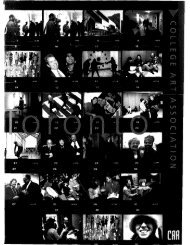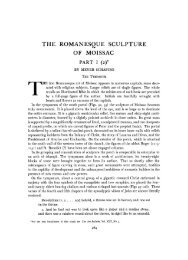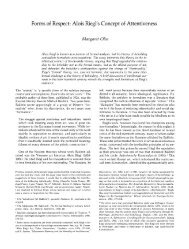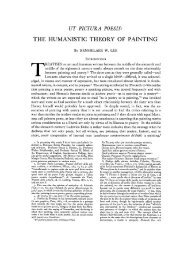Tragic Pompeii - College Art Association
Tragic Pompeii - College Art Association
Tragic Pompeii - College Art Association
Create successful ePaper yourself
Turn your PDF publications into a flip-book with our unique Google optimized e-Paper software.
254 THE ART BULLETIN JUNE 1994 VOLUME LXXVI NUMBER 2<br />
room (Fig. 34 d, e, f); it was a battle in which Achilles himself<br />
had participated.60<br />
The paintings in the House of the <strong>Tragic</strong> Poet were set up<br />
for different viewing experiences depending upon their<br />
location, but they expanded narrative space into peripheral<br />
areas like the spreading chorus of memory ideas described<br />
by Cicero and Quintilian. Instead of confining the more<br />
valued paintings to private dining rooms, the designer of this<br />
house encouraged the movement of the spectator as if the<br />
house were an actual, material counterpart to the familiar<br />
mansion of memory. Recall the method of the architectural<br />
mnemonic: one begins by putting the things to be remembered<br />
in the vestibule, then in the atrium, next into side<br />
rooms, and finally onto objects. The spectator chooses a<br />
certain route and orders the viewing itinerary, but is ultimately<br />
constrained by the built shell and by the placement of<br />
paintings within it. In reality, each exploration of a house<br />
would differ, for exterior conditions such as light or rain<br />
introduced an erratic temporal dimension that could alternately<br />
vitalize or dull the appearance of the paint. And one must also<br />
imagine that the spectator was accompanied by a knowledgeable<br />
companion who provided a "second-hand visual literacy."6''<br />
Whatever the route, the images must have reactivated<br />
knowledge of the ancient stories. For the educated viewer,<br />
their arrangements could prompt open-ended analogies and<br />
contrasts, calling up epic, drama, art, history, and evenwith<br />
the Stoics-contemporary moral questions. The narrative<br />
program of the house thus transcends the necessarily<br />
linear reading of literary texts, a process that at the time was<br />
further restricted by the conventions of the papyrus roll. A<br />
spectator could "rewrite" the story in a variety of ways simply<br />
by starting the viewing in different places and moving<br />
around and within rooms in different sequences. While the<br />
associations of each panel and the multiple connections<br />
among them induced a virtual polyphony of themes, the<br />
visual repetitions were building blocks, like long and short<br />
syllables, which the viewer/poet/artist manipulated into a<br />
variety of configurations to create different rhythms or visual<br />
narratives. Since each of the individual images evoked a host<br />
of related associations arising from a few large, binary<br />
themes, the precise significance of any single "reading" of<br />
the paintings was likely to vary in subtle ways. One thinks of<br />
the flexible memory of the oral poet or actor who improvised<br />
along known lines, producing a "new" version every time.<br />
60 On the "Amazon room," 6a: Roux Ain% (as in n. 12), I, 1820, 94-103,<br />
pls. 56, 57; for a line drawing of the back wall: W. Zahn, Neu entdeckte<br />
Wandgemalde zn Pompezz, Munich, Stuttgart, Tiibingen, 1828, pl. 9. The<br />
Amazon frieze is recorded in watercolors by Morelli in the Naples<br />
Museum: Pompez 1748-1980, 38-39, 188-189, and in a drawing by<br />
Niccolini (as in n. 12), I, 5. It is noteworthy that all the small rooms on<br />
the west side of the house deal with water themes in simple, two-figure<br />
scenes that are commonly found in <strong>Pompeii</strong> (i.e., Venus Fishing,<br />
Narcissus). For other Pompeian houses with programs "spilling out" of<br />
rooms, see Wirth (as in n. 36), on the House of the Vettii (VI.15.1) and<br />
my essay on the House of Jason (IX.5.18): "The Pregnant Moment:<br />
<strong>Tragic</strong> Wives in the Roman Interior," Sexualzty zn Anczent <strong>Art</strong>, ed. N. B.<br />
Kampen (forthcoming, Cambridge University Press).<br />
61 Harris (as in n. 2), 34-35, on the importance of intermediaries for<br />
"reading."<br />
Reanimation<br />
This tour of the House of the <strong>Tragic</strong> Poet has been selective,<br />
excluding not only rooms and alternate routes, but also the<br />
floors, ceilings, statues, furniture, and small objects that<br />
would have added to a rich array of excerpts. Yet the<br />
architectural mnemonic includes placing the things to be<br />
remembered onto objects like statues and paintings, and<br />
there are hints that the thematic harmony among the<br />
paintings in the house extended to other media. For example,<br />
in the tablinum, a theatrical theme was evident in the<br />
floor mosaic, the scenic masks painted in the adjoining<br />
cubicle (Fig. 33, room 6c), and a marble statue of a satyr<br />
found nearby. In fact, the juxtaposition of the Satyr Play<br />
Mosaic and the Alcestis panel highlights a compelling historical<br />
link: in the fifth century B.c., Euripides made an unusual<br />
substitution, presenting his Alcestis in place of a satyr play as<br />
the fourth performance in his dramatic cycle (Figs. 19-20).62<br />
The compositions of mosaic and painting are harmoniously<br />
coordinated, from the columns in the backgrounds to<br />
the focal frontality of Alcestis in the painting and of the<br />
wreathed aulos player in the mosaic; to the positions of the<br />
legs of the seated Admetus and of the choragos; and to the<br />
back views of the male figures (echoing those in the atrium<br />
panels), in the painting of the seated messenger and in the<br />
mosaic of the "satyr" standing on the left. The painter and<br />
the mosaicist clearly shuffled elements to coordinate the<br />
independent scenes in the tablinum. In a similar way,<br />
Boulanger, Hoffbauer, and the designer of the <strong>Pompeii</strong><br />
souvenir book rearranged borrowed figures to animate the<br />
atrium (Figs. 6, 8, 10). This is the method of the architectural<br />
mnemonic, whereby one inserts imagines (figures) into loci<br />
(atrium, tablinum, etc.)-in antiquity figural panels onto<br />
walls and floors, in modern reconstructions the inhabitants<br />
of <strong>Pompeii</strong> into the architectural shell.<br />
Within such a framework, it is tempting to imagine a visual<br />
dialogue among the various media and parts of the house. In<br />
the peristyle, the lararium could be seen as a thematic<br />
"pendant" to the Iphigenia panel at the opposite corner<br />
(Fig. 12, below). The actual altar, the center of the pious<br />
family cult tended by the paterfamilias, would thus be set<br />
against a mythical altar, implied if not actually depicted by<br />
the sacrifice of Iphigenia, as an archetypal image of impious<br />
family worship, perpetrated by the paterfamilias, Agamemnon.<br />
Indeed, the Roman paterfamilias was most likely a focal<br />
feature in the visual reception of the house. From the<br />
entrance, the visitor would have seen him seated on a dais in<br />
the tablinum, back-lit from the peristyle with the lararium<br />
prominent behind him, receiving calls from clients. His<br />
image would fit neatly into the scheme of seated males in the<br />
paintings of the atrium. And, like the seated choragos<br />
distributing masks on the mosaic below and Alcestis receiv-<br />
62 The marble faun wore a goat skin and carried bunches of fruit: Fiorelli<br />
(as in n. 10), 123. On the Alcestzs as a substitute for a satyr play: P.<br />
Riemer, Dze Alkestzs des Eurzpzdes. Beztrage zur klasszschen Phzlologze, cxcv,<br />
Frankfurt, 1989, 1-5. Rouveret, 314, draws an intriguing parallel<br />
between backstage scenes like that in the mosaic and the actor's art of<br />
memorization.










